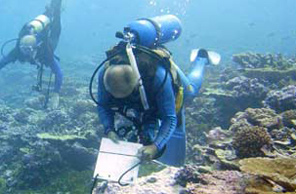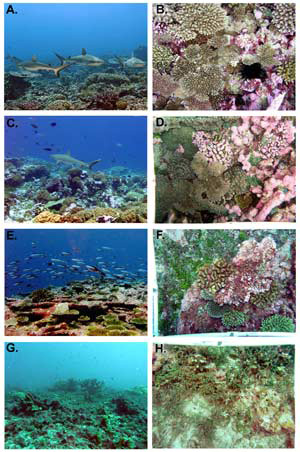Expedition finds inverted pyramid where sharks dominate marine ecology
Expedition finds inverted pyramid where sharks dominate marine ecology
mongabay.com
February 25, 2008
A survey of a remote Pacific archipelago turned up pristine coral reefs that could offer a “baseline” for measuring the human impact on reefs worldwide, report researchers from the Scripps Institution of Oceanography (SIO) at the University of California at San Diego.
The scientists surveyed four atolls in the Line Islands, part of a chain approximately a thousand miles south of Hawaii, with levels of human disturbance ranging from the uninhabited Kingman Reef to Christmas Island (Kiritimati), with a population of 5,000 people.
The assessment of Kingman Reef turned up an unusual find: an inverted food pyramid where predators such as sharks accounted for 85 percent of the total fish biomass.
 Rob Edwards, and Jim Maragos count coral along transect lines in virtually pristine conditions at Kingman Reef Rob Edwards, and Jim Maragos count coral along transect lines in virtually pristine conditions at Kingman Reef
|
This inverted pyramid “runs contrary to the bottom-heavy pyramids seen in other parts of the world where top predators have been fished out,” explained a statement from SIO. “Kingman also exhibited healthy coral populations and was nearly absent of seaweed and had low microbe concentrations, unlike evidence found elsewhere on disturbed reefs.”
Other reefs in the Line Islands chain showed signs of human impact, including declining coral health, fewer and smaller fish and an increase in microbes.
“This is the first study in which an entire coral reef community, from the smallest to the largest organisms, is described across a gradient of human habitation,” said Enric Sala, who led the 2005 expedition and is a coauthor of one of the two Public Library of Science (PLoS) ONE papers that describes the research. “We use Kingman as a window into the past, a time machine that allows us to understand what we have lost and how we lost it.”
“One of the major surprising findings from this study, with direct conservation relevance, is that the healthier reefs showed the capacity to recover from climate change events,” said Scripps Oceanography scientist Stuart Sandin, coordinator of the Line Islands Expedition and lead author the PLoS ONE paper. “When the ecosystem structure is intact, the corals appear to bounce back better from previous warm water events that have killed coral.”
The second PLoS ONE paper reports finding ten times more microbial cells and virus-like particles off Kiritimati compared with Kingman. The impact of microbes was clear: Kiritimati’s reefs had the highest percentage of coral disease and smallest coverage of corals
A third paper, published as an essay in PLoS Biology, discusses the importance of establishing baselines to measure changes in reef ecology.
“How to manage coral reefs locally in a globally changing world so that they retain or regain the critical ecosystem attributes of uninhabited reefs and still meet human needs is the central challenge facing reef conservation today,” write the authors.
“In a world of doom and gloom, it is important to know that reefs with exuberant coral growth and abundant fish populations still exist,” said lead author Nancy Knowlton, an adjunct professor at Scripps Oceanography and currently with the Smithsonian Institution. “These remote healthy reefs clearly show that local protection can make reefs resilient to the impacts of global change. The challenge is to translate the lessons of these reefs to management, so that reefs near people can also thrive.”
This article is based on a news release from SIO















